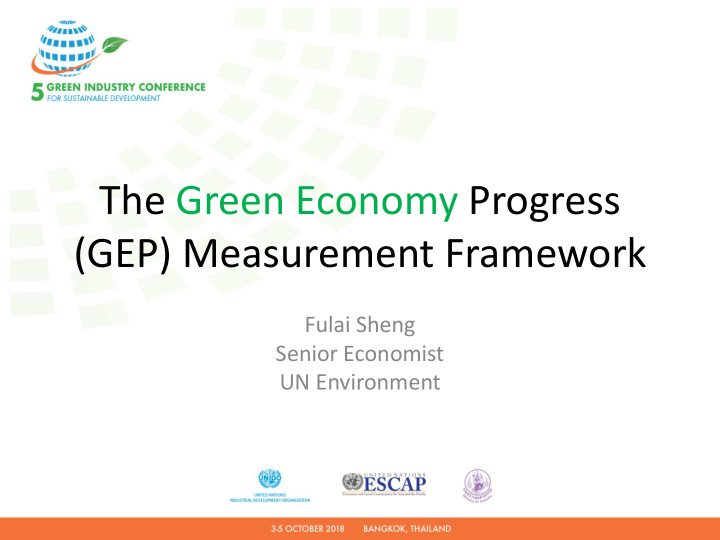



The Green Economy Progress (GEP) Measurement Framework Fulai Sheng Senior Economist UN Environment
The Green Economy Narrative • An Inclusive Green Economy (IGE): too l for sustainable development; response to 3 challenges : poverty, inequitable sharing of prosperity, and overstepped planetary boundaries. • IGE contributes to poverty eradication and shared prosperity by safeguarding planetary boundaries: climate, freshwater, ocean, and land covered by SDGs. • Need for an integrated and inclusive policymaking approach at the levels of policy goals and targets, policy choices, policy impacts, and policy participation by stakeholders.
The GEP Measurement Framework • GEP index: track progress relative to desired changes, impacting current well-being – weighted progress by countries on targets within thresholds across several indicators – Indicates a country’s overall progress towards IGE • Dashboard: monitors the sustainability of well-being for future generations – tracks main forms of natural capital & stocks of other capital that affects long term sustainability • GEP+ ranking: comparing dashboard indicators with GEP index .
Indicators • GEP index: 13 indicators – Related to Green Industry: green trade, green patents, material footprint, energy use, renewable energy • Dashboard: 6 indicators • Selection criteria – Mapping with IGE narrative – Data coverage (country and time) – Transparency and comparability (data accessibility) – Linkages with SDGs’ headline indicators (14 direct links to 10 of the 17 SDGs)
GEP index Measure IGE progress based on 3 ideas: 1. Identifying key IGE dimensions , each approximated by one or several variables; 2. Focusing on progress , i.e. changes rather than levels; 3. Measuring progress relative to targets & thresholds. Targets refer to desired changes, whereas thresholds define some critical levels; Weight 1 gives information at the indicator level with respect to the critical threshold, while weight 2 gives information about priorities across indicators.
Final Remarks • In 2014, 83 out of 105 countries (79%) progressed on IGE compared to 2004 – Remaining challenges: increasing material footprint & overstepped planetary boundaries • Dashboard: on average countries are making regress in sustainability indicators • GEP+: 17 out of 100 countries were able to make progress in dashboard & GEP index • Methodology: flexible (e.g. green industry) – UNIDO’s Green Industry programme and GEP Measurement framework under PAGE – Green Industry Progress (GIPro) Index for 18 Chinese Provinces using GEP methodology – GEP measurement framework & Inclusive & Sustainable Industrial Development (ISID) (in progress) • PAGE’s website: http://un-page.org/learning-resources/technical-guidance/green-economy- progress-measurement-framework
Recommend
More recommend